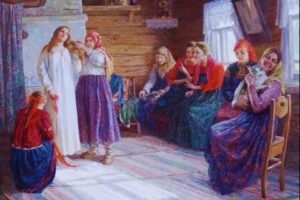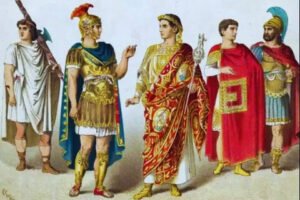Skip to content
Fashion Through the ages
Style, a steadily developing peculiarity, has been a mirror reflecting cultural changes, social impacts, and individual articulations from the beginning of time. From old civic establishments to current couture, the development of style has been a charming story of advancement, disobedience, and reevaluation. This article digs into the rich woven artwork of style through the ages, investigating its extraordinary excursion across various periods and landmasses.

Origins of Fashion
Design’s foundations can be followed back to old human advancements where dress filled both practical and representative needs. In Mesopotamia and Egypt, articles of clothing were made from normal filaments like material and decorated with multifaceted weaving, exhibiting societal position and strict convictions.
Fashion in Antiquity
In antiquated Greece and Rome, style thrived with hung articles of clothing, tunics, and robes exemplifying class and refinement. The frock, worn by Roman residents, represented citizenship and class qualification, while Greek clothing reflected goals of excellence and a majority rules government.
Medieval Fashion: A Tapestry of Elegance
The Medieval times saw the development of lavish textures, elaborate headwear, and custom fitted outlines. Middle age style was portrayed by complex subtleties, including weaved themes, fur-lined shrouds, and pointed shoes, reflecting progressive designs and strict impacts.
Renaissance: Rebirth of Style
The Renaissance period denoted a recovery of craftsmanship, culture, and style across Europe. Sumptuous textures, for example, silk and velvet embellished with pearls and valuable diamonds became inseparable from Renaissance style. Elaborate outfits, doublets, and farthingales mirrored the richness of the privileged and the blossoming shipper class.
Baroque and Rococo: Extravagance Redefined
The Florid and Lavish periods introduced a time of luxury and abundance, exemplified by intricate pieces of clothing decorated with trim, strips, and resplendent weaving. Style turned into a display of riches and status, with French court design starting precedents that reverberated all through Europe.
Industrial Revolution: Fashion for the Masses
The Modern Upheaval reformed style creation, prompting mass assembling and the ascent of prepared to-wear clothing. Developments, for example, the sewing machine democratized design, making upscale clothing open to the center and regular workers.
Victorian Era: A Study in Contrasts
The Victorian period was described by a division of unobtrusiveness and luxury. While ladies’ design embraced voluminous skirts and bodices, men’s clothing advanced with custom-made suits and formal extras. The Victorian period additionally saw the development of couture houses and style magazines, molding customer culture and patterns.
Roaring Twenties: The Jazz Age Revolution
The Thundering Twenties represented freedom and resistance, reflected in the design of the time. Flapper dresses, cloche caps, and Workmanship Deco adornments typified the soul of the Jazz Age, testing customary standards of gentility and style.
Golden Age of Hollywood: Glamour and Elegance
The Brilliant Time of Hollywood introduced a period of allure and complexity, with cinema symbols setting style around the world. From predisposition slice outfits to custom-made suits, Hollywood style embodied immortal polish and appeal, enrapturing crowds and rousing architects long into the future.
Swinging Sixties: The Age of Youthquake
The Swinging Sixties saw a social unrest, with design mirroring the soul of resistance and freedom. Smaller than usual skirts, hallucinogenic prints, and mod styles characterized the design of the time, testing shows and praising youth culture.
Disco Era: Glitter and Glamour
The Disco Time of the 1970s embraced showiness and overabundance, with discotheques turning into the focal point of style and nightlife. Sequined dresses, stage shoes, and polyester textures encapsulated the disco tasteful, typifying a feeling of idealism and gratification.
Punk Movement: Rebellion and Subversion
The Troublemaker development of the last part of the 1970s opposed standard style, embracing Do-It-Yourself feel and anarchistic philosophies. Cowhide coats, self clasping pins, and tore pants became images of defiance, testing cultural standards and reclassifying design as a type of dissent.
1980s: The Decade of Excess
The 1980s typified abundance and lavishness, with power dressing and obvious utilization characterizing the design of the period. Shoulder braces, neon tones, and curiously large outlines mirrored the success and commercialization of the 10 years, while music and mainstream society impacted style on a worldwide scale.
1990s Grunge: A Return to Reality
The 1990s saw a reaction against the fabulousness of the earlier ten years, with grit style arising as a nonconformist development. Wool shirts, battle boots, and tore denim exemplified the counter design stylish of grit, mirroring a craving for credibility and independence.
21st Century: Fashion in the Digital Age
The 21st century has seen design advance pair with innovation and globalization. Maintainable design, streetwear culture, and advanced powerhouses have reshaped the business, testing customary thoughts of magnificence and style. With online entertainment stages driving patterns and openness, design has become more comprehensive and different than any time in recent memory.
The Dawn of Style: Early Civilizations
Exploring Ancient Mesopotamian Garments
The support of civilization, Mesopotamia, laid the preparation for style with its many-sided articles of clothing created from material and fleece. Mesopotamian clothing was practical as well as representative, reflecting societal position and strict convictions.
Egyptian Elegance: The Legacy of Pharaohs
Egyptian design encapsulated tastefulness and extravagance, with streaming robes, many-sided gems, and famous crowns decorating the two royals and ordinary people the same. The perfect craftsmanship of Egyptian materials stays unparalleled right up to the present day.
Greek Drapery: The Birth of Classicism
Old Greece presented the idea of curtain, where articles of clothing were capably wrapped and creased to make agile outlines. The frock, chiton, and himation became inseparable from Greek clothing, representing a vote based system and imaginative greatness.
Roman Influence: Conquest and Couture
Roman style was a combination of reasonableness and extravagance, mirroring the domain’s huge triumphs and various societies. From the hung tunics of average people to the intricate robes of legislators, Roman dress represented power, status, and social digestion.
Medieval Majesty: Feudal Fashion
Medieval Europe: The Age of Chivalry
Archaic style was directed by primitive ordered progression, with sumptuary regulations managing clothing in light of social class. Knights decorated themselves in chainmail and defensive layer, while aristocrats wore elaborate outfits adorned with weaving and gems.
Byzantine Brilliance: The Splendor of the Eastern Empire
The Byzantine Realm was famous for its rich materials and complicated embellishments. Byzantine style leaned toward luxuriously colored silks, elaborate brocades, and sumptuous embellishments, mirroring the realm’s abundance and impact.
Islamic Fashion: Elegance and Modesty
Islamic style embraced unobtrusiveness and refinement, with baggy articles of clothing and sensitive embellishments decorating all kinds of people. The hijab, abaya, and kaftan became notable images of Islamic personality and social pride.
Far East Fashion: Silk Road Splendor
The Silk Street worked with the trading of merchandise and thoughts across Asia, prompting a combination of styles and methods. Chinese silk, Japanese kimonos, and Indian saris typified the magnificence and craftsmanship of Far East design.
Renaissance Revival: Artistic Flourish
Renaissance Italy: The Rebirth of Fashion
The Renaissance brought a recovery of traditional feel, with Italian fashioners embracing extent, equilibrium, and evenness in their manifestations. Renaissance design commended the human structure, with customized articles of clothing and perplexing embellishments enhancing the tip top.
Baroque Extravagance: The Age of Ornamentation
Elaborate style was described by its sumptuous embellishments, rich textures, and extreme outlines. Rococo pieces of clothing were a festival of riches and status, with many-sided trim, elaborate weaving, and voluminous skirts enhancing the honorability.
Rococo Romance: The Flourish of Frivolity
Ornate style embraced silliness and abundance, with sensitive textures, pastel tones, and unpredictable embellishments enhancing the privileged. Extravagant pieces of clothing were an ensemble of trim, unsettles, and strips, encapsulating the unusual appeal of the period.
Enlightenment Elegance: The Age of Reason
The Illumination introduced a period of judiciousness and restriction, reflected in the straightforwardness and refinement of Neoclassical style. Neoclassical pieces of clothing inclined toward clean lines, lightweight textures, and negligible embellishments, representing a takeoff from overabundance and pomp.
Industrial Revolution: Fashion in Flux
Victorian Virtue: The Cult of Domesticity
Victorian design was an impression of cultural qualities, with unobtrusiveness, devotion, and decency valued regardless of anything else. Victorian ladies embellished themselves in layers of texture, girdles, and crinolines, while men brandished custom-made suits and formal hats, representing status and appropriateness.
Art Nouveau: The Dawn of Modernism
Craftsmanship Nouveau design embraced regular structures and streaming lines, leaving from the inflexibility of Victorian style. Craftsmanship Nouveau pieces of clothing included natural themes, delicate curtain, and creative materials, flagging a shift towards innovation and creative liberty.
Edwardian Elegance: The Last Hurrah of Aristocracy
The Edwardian period was a period of tastefulness and luxury, with rich pieces of clothing mirroring the plushness of high society. Edwardian ladies embraced the S-bend outline, while men leaned toward custom fitted suits and formal clothing, exemplifying the refined preferences of the gentry.
Jazz Age Glamour: The Roaring Twenties
The Thundering Twenties was 10 years of freedom and trial and error, reflected in the strong and thinking for even a moment to design decisions of the flappers. Jazz Age design was described by its short hemlines, dropped midsections, and adorned headbands, representing opportunity, youth, and defiance.

FAQs (Frequently Asked Questions)
How has configuration influenced society starting from the dawn of history? Style has filled in as an impression of cultural qualities, social developments, and individual characters, forming discernments and ways of behaving across various times.
Which job did design play in antiquated civic establishments? In antiquated developments, style filled both useful and emblematic needs, reflecting societal position, strict convictions, and social personalities.
How did the Modern Upset affect form? The Modern Unrest reformed design creation, prompting mass assembling and the democratization of beautiful clothing for the general population.
Who were a few persuasive figures in style history? Powerful figures in design history incorporate creators, style symbols, and social powerhouses who lastingly affect the business and mainstream society.
How has innovation impacted present day design? Innovation has upset present day style with advancements like 3D printing, wearable tech, and online retail stages, changing the manner in which we configuration, produce, and consume clothing.
What are a few arising patterns in contemporary design? Contemporary style incorporate supportability, orientation ease, and inclusivity, reflecting moving cultural qualities and a longing for realness and self-articulation.
Conclusion
Style is a dynamic and consistently developing work of art, mirroring the social, social, and political scene of now is the right time. From the hung articles of clothing of antiquated human advancements to the vanguard manifestations of present day creators, style has ceaselessly pushed limits and tested shows. By understanding the development of design through the ages, we gain knowledge into our aggregate history and personality, commending the innovativeness and variety of human articulation.



